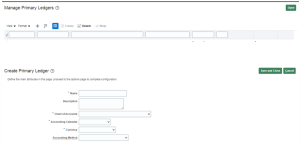Create Primary Ledger
Create a primary ledger as your main record-keeping ledger. A primary ledger records transactional balances by using a chart of accounts with a calendar, currency, and accounting rules implemented in an accounting method. The primary ledger is closely associated with the subledger transactions and provides context and accounting for them.
Navigator: Setup and Maintenance–> Financials–> General Ledger–>Manage Primary Ledgers.
Select + to create the primary ledgers.

Scenario
You have been assigned the task of creating a primary ledger for your company Vision Corporation.
- In the Setup and Maintenance work area, go to the following:
- Offering: Financials
- Functional Area: General Ledger
- Task: Manage Primary Ledger
- Click the Create icon.
- Complete the fields, as shown in this table.
| Field | Value |
| Name | Vision Corporation |
| Description | Vision Corporation primary ledger for recording transactions. |
| Chart of Accounts | Vision Corporation Chart of Accounts |
| Accounting Calendar | Standard Monthly |
| Currency | USD |
| Accounting Method | Standard Accrual |
- Click Save and Close.
Note: You can’t change the chart of accounts, accounting calendar, or currency for your ledger after you save the ledger.
Specify Ledger Options
This example demonstrates specifying the ledger options for a primary ledger. Your company, InFusion Corporation, is a multinational conglomerate that operates in the United States (US) and the United Kingdom (UK). InFusion has purchased an Oracle Fusion Enterprise Resource Planning (ERP) solution including Oracle Fusion General Ledger and all of the Oracle Fusion subledgers.
After defining your InFusion America Primary Ledger, in the Setup and Maintenance work area, go to the following:
- Offering: Financials
- Functional Area: General Ledger
- Task: Specify Ledger Options, with the ledger scope set
Note: Both primary and secondary ledgers are created in the same way and use the same user interface to enable their specific ledger options.
Reviewing General Options
- Accept the default name and description for the selected ledger.
- Review the currency and chart of accounts for the specified ledger, which are automatically provided.

Setting Accounting Calendar Options
- Review the accounting calendar that defaults from your ledger.
- Select Jan-2019as the first open period for your ledger.
Select a period after the first defined period in the ledger calendar to enable running translation. You can’t run translation in the first defined period of a ledger calendar. In this example, your calendar began with Jan-2016.
- Enter 3in the Number of Future Enterable Periods
Any value between 0 and 999 periods can be specified to permit entering journals, but not posting them in future periods. Minimize the number of open and future periods to prevent entries in the wrong period.
![]()
Selecting Subledger Accounting Options
- Accept the default accounting method from your ledger.
- Select US American Englishas your journal language.
![]()
Completing the Period Close Options
- Enter your retained earnings account: 101-00-31330000-0000-000-0000-0000.
This account is required. General Ledger moves the revenue and expense account balances to this account at the end of the accounting year.
- Enter your cumulative translation adjustment account: 101-00-31350000-0000-000-0000-0000.
The Cumulative Translation Adjustment (CTA) account is required for ledgers running translation.
- Don’t enter a value for the Default Period End Rate Typeor Default Period Average Rate Type
The values entered here are used as the default for balance level reporting currency processing. InFusion America Primary Ledger is using the subledger level reporting currency processing.

Specifying Journal Processing Options
- Complete the fields, as shown in this table.
| Field | Value |
| Enable Suspense | General Ledger |
| Default Suspense Account | 101-00-98199999-0000-000-0000-0000 |
| Rounding Account | 101-10-98189999-0000-000-0000-0000 |
| Entered Currency Balancing Account | 101-10-98179999-0000-000-0000-0000 |
| Balancing Threshold Percent | 10 |
| Balancing Threshold Amount | 100 |
- Enable the following entry and import options:
- Enable journal approval: Enable the journal approval functionality.
- Notify when prior period journal is entered: Notify the user when a prior period date is selected on a journal entry.
- Allow mixed and statistical journals: Enter both monetary and statistical amounts on the same line in a journal entry.
- Validate reference date: Require a reference date in an open or future enterable period.
- Separate journals by accounting date during journal import: Create individual journal entries for each accounting date.
- Select InFusion America Accrual Set from the list of values in the Journal Reversal Criteria Setfield and click the Run Auto Reverse after open period option to reverse accrual journal entries automatically when a new period is opened.
- Click the Enable intercompany accountingoption to enable automatic balancing for primary, second, and third balancing segments on intercompany journals and transactions.
To complete the intercompany accounting functionality, you must define intercompany rules.
Note:
- This example describes setting options for a standard ledger. You can convert a standard ledger to an average daily balance ledger before the first period is opened by selecting the Enable average balancescheck box on the Specify Ledger Options page.
- You can also convert an average daily balance ledger to a standard ledger before submitting the Review and Submit Accounting Configuration task, provided the average daily balance ledger wasn’t created through the rapid implementation process.

